About The QL

About The QL |
 |
Updated: 18.07.2005
|
The Sinclair QL was Sir Clive Sinclair's first serious attempt at a computer for business. It followed the ZX Spectrum, ZX81 and ZX80 in 1984. The QL signalled a move away from Sinclair's "traditional" use of the Z80 processor to a multi-tasking system based on a 68008 processor and 8049 second processor. The QL is a good example of a machine with a structured on-board version of BASIC called SuperBASIC, and a multi-tasking operating system (QDOS), which was quite an innovation back in its launch days! |
 |
 |
 |
 |
 |
 |
| Tony Tebby | David Karlin | Jan Jones | Laurence Reeves | Marcel Kilgus |
The QL is often regarded as not one of Sir Clive's successes, but while it is true to say that it did not sell in anywhere near as large a number as the Spectrum, the QL gained (and still retains!) a faithful band of followers, largely thanks to Tony Tebby's innovative multi-tasking operating system QDOS which has been more recently developed into a form known as Minerva, by programmer Laurence Reeves. The QL hardware was designed by David Karlin, while the SuperBASIC interpreter was developed by Jan Jones. Tony Tebby later developed a compatible but more modern version called SMSQ/E available for several platforms, most notably QLs and their derivatives and as emulators for PCs and Atari STs. SMSQ/E is today developed and maintained by Marcel Kilgus and the operating system sources are available to developers at http://www.scp-paulet-lenerz.com/smsqe/ thanks to SMSQ/E Registrar, Wolfgang Lenerz.
At around the time of its launch in 1984, the QL had a choice of operating systems in QDOS and another windowing system from GST, called 68kOS, available as a plug in card from GST.
The specifications of the original QL are listed below.
| Processor | 7.5MHz Motorola MC68008 |
| RAM | 128KB, expandable to 640KB or 896KB |
| ROM | 48KB on board - QDOS and SuperBASIC |
| Plug-in ROM | 16KB via ROM connector port |
| Storage | Two 100KB microdrives (removable tape loop cartridges) |
| Display | 512x256 in 4 colours, 85x25 text; 256x256 in 8 colours, 42x25 text |
| Operating system | QDOS, Single user pre-emptive multitasking |
| Expansion ports | Main I/O connector, EPROM connector, 2 joystick ports, 2 RS-232-C ports, TV modulator, RGB monitor, Composite video, External microdrives, 2 QL network sockets. |
| On board programming language | QL SuperBASIC (Sinclair's structured BASIC interpreter) |
| Supplied software | Quill word processor, Abacus spreadsheet, Archive database, Easel business graphics. Some QLs were also supplied with a games cartridge. |
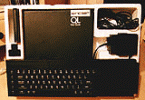
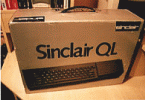
The QL was officially launched on the 12th of January 1984 at a high profile launch event at the Intercontinental Hotel, Hamilton Place, London, which was actually about 12 days before the launch of the Apple Mac! The QL received somewhat mixed reviews.
It is often said that the launch of the machine went some way to killing off the computer's chances of success - launch delays, unfinished operating system, bug-ridden BASIC interpreter, partly finished software supplied with the machine, and the use of Sinclair's microdrive tape cartridges instead of the floppy disk drives that most would have preferred at the time for a home and business computer. Undaunted, Leon Heller and Brian Pain started a user group before the first QLs arrived with users. This user group was then called IQLUG (the Independent QL User Group) - it was later to become the user group we now know as Quanta.
Once in the hands of users and with updated system ROMs, the machine was able to prove itself quite readily, especially when foppy disk drive systems and good software became available. But by then, the press had had a field day basing reviews of the machine on the launch version. The QL never really recovered enough to gain the reputation it really deserved. A drastic price cut (halving the QL's price) helped, but eventually Sinclair chose to sell his computer business to Amstrad, who decided to discontinue the QL.


Some of the original Sinclair engineers had left the company. Among these was Tony Tebby who set up a company called QJump to produce software for the QL. One of QJump's earlier efforts was Toolkit 2, an improved version of the original QL Toolkit (also by QJump) from Sinclair's software division. Toolkit 2 was to become one of those essential add-ons no QL user should be without. It greatly extended the SuperBASIC interpreter and provided access to additional operating system facilities that many thought should have been present in the first place. Toolkit 2 (commonly abbreivated to TK2) was originally available either as a plug in EPROM cartridge or as a 'configurable' version on disk or microdrive, which allowed you to select parts of the Toolkit for use, rather than use the whole lot. The disk version quietly disappeared over the years as larger memory systems became more common and more interfaces began to include the whole TK2 on board. QJump also produced a mouse interface and the QRAM system, which provided true windowing and pointer control of software. Although QRAM itself has been superceded by systems like QPAC2, the core pointer environment remains popular, almost essential, among users to this day. The SMSQ/E operating system for QL and compatibles has a version of the pointer environment built in (the E in SMSQ/E stands for Extended environment).
Third party hardware and software suppliers kept on producing QL products and the users enjoyed quite good levels of supports. A regular magazine (QL User) and a strong user group (Quanta) helped to maintain strong interest in the QL. Several books and magazines were published for the QL over the years - you can still get hold of many of these via the traders who supply "second user" material for the QL. Programming utilities such as assemblers and compilers, along with a well documented operating system (Sinclair had released a programmer's reference guide) ensured it was fairly easy to produce add-ons and software for the QL. Three good BASIC compilers were released in SuperCharge, Turbo and QLiberator which allowed even less experienced programmers to produce surprisingly good software for the QL. One of the designers of SuperBASIC, Jan Jones, released a reference guide to the BASIC interpreter which complemented the information in Sinclair's manual.
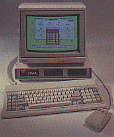 |
A company called CST (Cambridge Systems Technology) produced a computer based on the QL, called Thor, in conjunction with a company called Dansoft in Denmark. The original version used a QL circuit board built into a metal case with memory expansion and disk drives built in and CST developed QDOS to become a system known as Argos - at the time many said that this is what the QL should have been, or at least what the QL mk 2 should have been. A later version called the Thor XVI used a 68000 processor, but neither became particularly popular, and CST (and the Thor itself) later disappeared in less than happy circumstances. |
 Early
hardware add-ons for the QL concentrated on three main types of system
Early
hardware add-ons for the QL concentrated on three main types of system
One of the problems faced by hardware designers was that the QL had only one expansion port, so you could either add a memory expansion or a disk interface, but not both. Some companies such as CST produced 2 and 4 slot expansion systems which sat to the left of or under the QL, though these were not that popular. Others tackled the problem by putting through connectors on their memory expanders so that disk interfaces could be plugged into the end of the memory expanders. Although this was successful and popular, its disadvantage was that it could in some cases greatly increase the width of the QL - single interfaces fitted partly inside the QL, but the second interface usually lived wholly outside the QL, including exposed electronics (some companies provided plastic or metal covers in this case)
Some companies such as Medic Data Systems, Technology Research and Miracle Systems started to produce all-in-one expansion devices. These would include a memory expansion and disk interface, and some added parallel printer ports and an on-board version of Toolkit 2. The longest surviving of these devices was the Trump Card, produced by Miracle Systems Ltd. The Trump Card took the system RAM from the theoretical design limit of 640KB to a maximum of 896KB by utilising unused addressing space in the design of the computer. The processor itself could only access 1MB, so the Trump Card was a total solution, though also a somewhat dead-end one as there was no way to address any more address space.
 |
 |
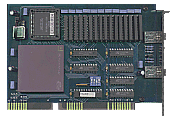 |
 |
| Trump Card | Gold Card | QXL | Super Gold Card |
Left to right, the pictures show Miracle Systems' Trump Card, Gold Card, QXL and Super Gold Card.
Later add-ons followed this route. The Gold Card system from Miracle Systems was a revolution in that it provided a new microprocessor (68000) and 2MB of RAM for the first time. Processor speed went up to 16MHz and software ran many times faster than users were used to. It also added the capability to use HD and even ED (3.2MB) disk drives for the first time. The Gold Card enjoyed great success.
Miracle's next product was the ill-fated QXL emulator card for the PC, which introduced the SMSQ operating system development. The QXL used a 20MHz (25MHz in later versions) 68EC040 processor and up to 8MB of RAM. Though delayed and dogged by a late operating system, the QXL was a revolution in that it provided the users with the facility to include a complete QL compatible system (down to network ports) within a PC, and have it run software much, much faster than a QL and with vastly bigger memory and an improved, more up to date operating system.
The delays and problems with the QXL gave Miracle the chance to launch an enhanced Gold Card add-on for the QL itself, called the Super Gold Card. 4MB of RAM and a 24MHz 68020 processor gave the best possible expansion for the original QL.
Most of Miracle's offerings were 'dead-end' solutions in that it was not possible without considerable ingenuity to further expand the QL. Some companies built add-ons which used the EPROM slot on the back of the QL. This had proved awkward, because the EPROM slot is read-only, it is not normally possible to write to anything connected to the port. As the commonest add-on for that slot was a Toolkit 2 EPROM cartridge, but many users now had Toolkit 2 supplied on board their disk interfaces, an ingenious system of outputting data whereby a 'double' access was made to the EPROM socket, the first effectively outputting an address, and the second effectively outputting the data was devised. This was used by Miracle Systems for their hard disk system and by Italian hardware producer SPEM for their video digitiser. CL Systems also produced a video digitiser, others produced parallel ports and so on.
Another hardware based QL emulator was that produced for the Atari ST range of computers. Originally manufactured by Futura Datasenter in Norway, this was subsequently enhanced and produced by Jochen Merz Software. The ST emulator card was particularly popular in countries like Germany. A later development was the QVME card.
Di-Ren and TF Services among others produced keyboard interfaces which allowed a standard external PC style keyboard to be plugged into the QL. Di-Ren produced a system called Amadeus, designed to allow expansion via a token-ringed network. Originally conceived to allow sound cards, I/O cards, high speed serial and bidirectional parallel cards, this system never really captured the imagination. TF Services produced a replacement for the Sinclair ROMs known as Minerva - essentially a slightly enhanced QDOS without the bugs! A second version, Minerva MkII, included an I2C bus allowing easy add-on of peripherals compatible with this system. They also produced a replacement for the QL's second processor (the 8049 chip) known as Hermes. This fixed various problems with the original and was considered a great improvement. A later version, SuperHermes, added facilities such as keyboard interface and high speed serial ports.
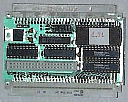 QUBIDE |
Qubbesoft aided by Croatian hardware designer Zeljko Nastasic (known to most as Nasta) produced the classic Qubide hard disk system (left), which allowed standard IDE hard drives to be used with the QL for the first time. The software for this system, based on that used with the earlier Rebel hard disk system, was implemented by Phil Borman, who also produced the PBOX bulletin board software for the QL. Most of the QL BBSes running today use the PBOX software. Qubbesoft also produced a QL-compatible Aurora motherboard (right), which involved using some standard QL parts to complete the board, but allowed you to more easily mount the 'QL' into a standard AT style PC case. The Aurora was more compact than the QL motherboard and did not make use of the microdrives at all. The video display was enhanced to give resolutions up to 1024x768 in up to 256 colours (it was possible to use the existing colour modes at this resolution though sadly operating system support for this level of colour depth did not arrive until after its production was discontinued!) |
 Aurora |
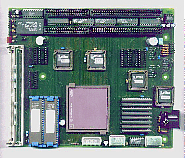

The first of the Qx0 series of computers was the Q40. Marketed by QBranch and well received, that machine is no longer produced. The latest QL replacements are the Q40i and Q60, designed by Peter Graf in Germany. Peter's brother Claus maintains a Web site for these machines (see link below) and writes application software for them. It is produced and marketed in the UK by Derek Stewart and Dennis Smith of D & D Systems. It is the fastest QL-compatible system yet, featuring a 40MHz 68040 (Q40i), up to 128MB of RAM, 16 bit colour video and much improved sound capabilities among its many enhancements over a standard QL in a Q40i, while a Q60 features a 68060 processor at 66 or 80MHz, MMU, up to 160 BogoMIPS performance for QDOS and SMSQ/E, 4 to 128 MB of RAM, 256 to 1024KB of ROM, 65536 colours at 1024x512 resolution, 20kHz stereo sound and many other enhancements. These machines are now being manufactured by D&D Systems, P.O.Box 5813, Ripley, Derbyshire, DE5 9ZR, England. It has a choice of up to 3 operating systems - QDOS Qlassic (Mark Swift), SMSQ/E or Linux for Q40 or Q60. At the time of writing this, the SMSQ/E operating system for these computers included support for the high colour modes, and a version of the Linux operating system had been ported by Richard Zidlicky in Germany, meaning that not only is this probably the best QL-compatible system in its own right, it is also a pretty decent Linux platform to boot. QBranch sent me an 11 page Tony Tebby document about the Graphic Device Interface Version 2 (GD2 screen driver) which is a useful programmer's document to the new screen driver and extended colour support, including documentation of the new SBASIC keywords, including a new keyword to support loading of screen images as wallpaper with the BGIMAGE command. I'm sure this document shows that there is a commitment to encouraging the development of software for the new system. Jonathan Hudson has now ported a sound conversion utility called sox to QDOS, available from his Web site, which will help Q40/Q40i/Q60 users convert sound files such as .wav files to the unsigned byte _ub format used by the Qx0 machines. Visit the website via the link below for Q40/Q60 software, news and further details on this remarkable computer!
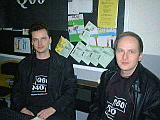 |
 |
 |
 |
| Claus (left) and Peter Graf | Dennis Smith | Derek Stewart | A Q60 computer |
Q40 Web site | QDOS Classic site | Richard Zidlicky's site | Jonathan Hudson's site
A number of QL emulators have been released for various computer systems, including Atari ST, Amiga, Windows, DOS, Linux and Macintosh, and these are covered in the QL Emulators page on this website.
I am often asked this question. My answer is shown below - this is why I have stayed with QL-type systems over the years.